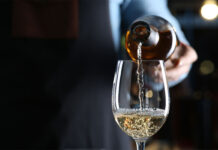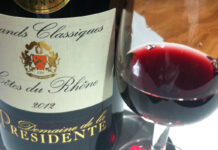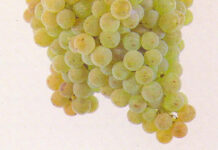Luke Richardson is the sommelier at wine bar Le Di-Vin in Edinburgh. In his column for SLTN he shares his thoughts on all things wine-related and answers your questions about wine. If you have a question for Luke email it to sltn@peeblesmedia.com
 HI again!
HI again!
Last time I started talking about the Riesling grape, and we learned that it makes highly acidic, fresh and age-worthy white wines with a wide range of flavours.
We also saw that the higher the ABV, the drier the wine. So let’s look at region styles around the world.
The spiritual home of the grape has to be Germany, but it is also one of the hardest to understand.
I could easily spend a couple of columns just on Germany to be honest, but in terms of iconic sites, then the Mosel would be my go-to area, producing light and crisp styles with ripe fruit but a fresh and crisp finish.
Here, the value-for-quality style to go for is Kabinett. Wines range from dry (11% ABV) to medium/sweet (8.5% ABV). The drier styles make the perfect aperitif wine – crisp Granny Smith apple with a hint of the flavour of honey on a slatey mid palate, with lashings of linear acidity whooshing through the palate after and leaving you salivating for more. Amazing with oysters.
The medium-sweet examples are better with smoked fish, or particularly oily fish like mackerel. They are generally pretty good with all seafood, but seem to excel with the oilier fish. Expect to pay around £9 plus VAT per bottle for something straightforward, and something pretty decent around £11+.
The next region would have to be Alsace, in north-east France. Here, thankfully, the wines are all dry unless they are dessert wines, which makes it easier.
The general style is rich, opulent, round and ripe, but very mineral in the mid palate and packed with bags of juicy acidity in the tail. In fact, if a Riesling doesn’t make you pucker up your cheeks a little, then it’s probably not very good. Think peach, petrol, slate and lemons.
There are some OK examples around £9 plus VAT, but much better ones at £10.50+, and world class for around £20+. They’re good with a wide range of food: Caesar salad, simple fish dishes – especially salmon/mackerel/trout – creamy poultry, bacon and onion tart, smelly cheese. The list is long!
I think hot smoked salmon, Hollandaise and baby new potatoes would be a favourite combination for a good Alsatian Riesling.
For a lighter but still dry style, Australia is a good shout – the area around Adelaide being the best in my opinion.
Clare Valley is a region known for its racy, light, taut Rieslings, less petrol in the first couple of years, but developing later with bottle age.
Lemons and limes, hints of slightly unripe nectarine, flint/slatey mid, and recurring juicy lemon acidity, these are somehow fresher and simpler, but no less delicious.
A slightly lighter style of food along a similar theme to before, so fish salads, pan-pacific seafood cooking, that sort of thing. I like it with olives before dinner – refreshing and clean. Everyday bottles are a bit cheaper, £7.50 to £8 plus VAT, but it’s worth spending £9 to £10+.
In general, Riesling shows the ground it’s grown in very well, but to do this well takes a fairly high quantity of good quality grapes. Of all the white varieties, it is definitely the one to spend a couple of pounds more on.
The cheapest examples lack the oomph that a decent Riesling has – they should be powerful, yet elegant, linear and yet ripe, racy and yet balanced. I guess it’s a love or hate thing – and if you love one Riesling, chances are you’ll love them all. Cheers!



















